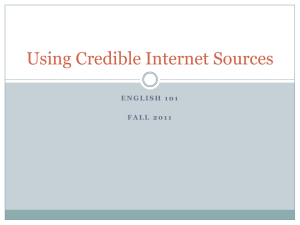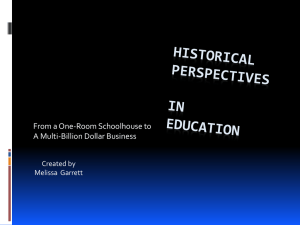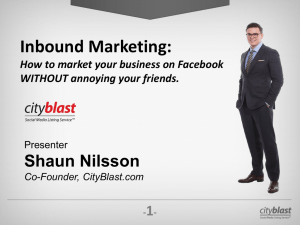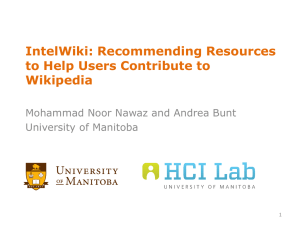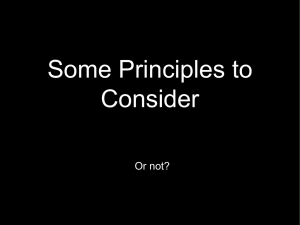PowerPoint Slides - Association for Psychological Science
advertisement
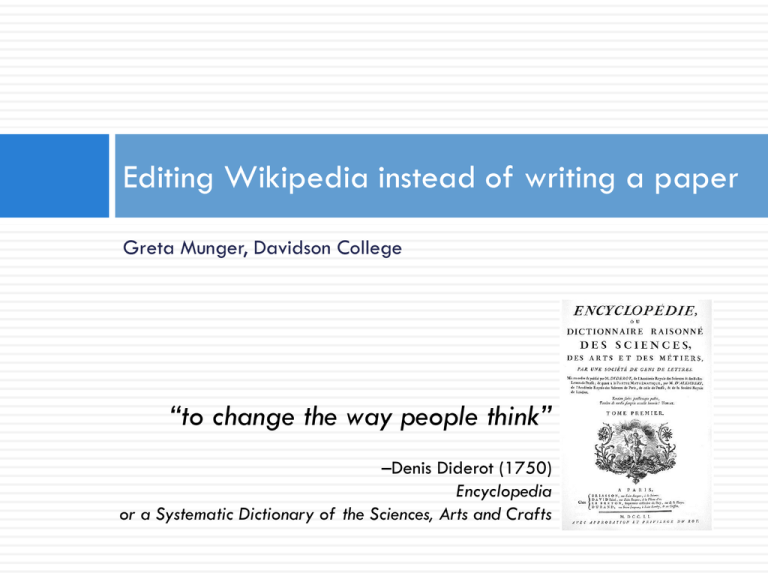
Editing Wikipedia instead of writing a paper
Greta Munger, Davidson College
“to change the way people think”
–Denis Diderot (1750)
Encyclopedia
or a Systematic Dictionary of the Sciences, Arts and Crafts
Civic engagement
…to assist students in developing humane instincts
and disciplined and creative minds for lives of
leadership and service…
Davidson
College Mission Statement
Developing the assignment
Defining an entry
Initial
definition
Imagine
this is all they read, what to know?
Methods
How
do we define and measure this?
Specific
This
results
is the bulk of the article.
Theory
To
the extent that there is some consensus.
Wikipedia assignment
Traditional literature review
Students
work individually
1500-2000 words
4-6 peer reviewed sources
Wikipedia project
Students
in pairs
No specific word count
Add 15 peer-reviewed sources
Wikipedia Day 1
Registering, linking, and markup
User page details…
Register at Wikipedia
Link to Davidson College (external)
Link to course page
APS template
Infobox user template (make it pretty!)
Talk to a fellow classmate on their User page
Say “hi” to Online Ambassador
“Meet & greet” section of his talk page
Places to register…
Register at APS
Add your name to the list of students on our course page
Wikipedia Day 2
Finding sources and adding references
Citation
wizard, DOI search
Markup
What you see in textbox
Mental rotation is the ability to manipulate mental representations of two-dimensional and
three-dimensional objects about various axes of rotation, with larger orientation
differences require more processing time<ref>{{cite journal|last=Shepard|first=R.
N.|coauthors=Metzler, J.|title=Mental Rotation of Three-Dimensional
Objects|journal=Science|date=1971|volume=171|issue=3972|pages=701–
703|doi=10.1126/science.171.3972.701}}</ref> <ref>{{cite
book|last=Revlin|first=R|title=Human Cognition Theory and
Practice|year=2012|publisher=Worth Pub|isbn=9780716756675|pages=237241}}</ref>.
{{reflist}}
What you see as the preview (and when page is saved)
Mental rotation is the ability to manipulate mental representations of two-dimensional and
three-dimensional objects about various axes of rotation, with larger orientation
differences require more processing time[1] [2].
1. ^ Shepard, R. N.; Metzler, J. (1971). "Mental Rotation of Three-Dimensional Objects". Science 171
(3972): 701–703. doi:10.1126/science.171.3972.701.
2. ^ Revlin, R. Human Cognition Theory and Practice. Worth Pub. pp. 237-241. ISBN 9780716756675.
Wikipedia Day 3
Articles & partners assigned
Article
structure described
Develop tentative list of sources
Goal:
15 peer reviewed articles by next week
A quick visual
Writing concisely
Typical student sentence
APA rewrite
“In a study done by Brown and Munger (2010), they manipulated
whether the camera was rotating or translating through the scene
and found larger representational momentum for rotations.”
“Brown and Munger (2010) found larger representational
momentum for camera rotations compared to translations.”
Wikipedia rewrite
“More representational momentum occurs for camera rotations
compared to translations through a scene.[1]”
1. ^ Brown, Travis A.; Munger, Margaret P. (2010). "Representational momentum, spatial layout, and
viewpoint dependency". Visual Cognition 18: 780–800. doi:10.1080/13506280903336535.
Content & focus, not just length
Results
200-level course
29 undergraduates, 220+ refs
Childhood amnesia
Confabulation
Culture in music cognition
Deese-Roediger-McDermott paradigm
Embodied cognition
Encoding specificity principle
Eyewitness memory
Flashbulb memory
Global precedence
Misinformation effect
Music and emotion
Psychological refractory period
Reminiscence bump
Subliminal stimuli
~6000 page views per month
400-level course
12 undergraduates, 180+ refs
Door-in-the-face technique
Eustress
Impression formation
Insight
Latent learning
Obedience (human behavior)
Perfectionism (psychology)
Personnel Psychology
Posture (psychology)
Realistic conflict theory
Reminiscence therapy
Self-serving bias
~9000 page views per month
Summary
Student reflections
Sense of purpose
Audience awareness
Concise writing
Argument
Source awareness
Article structure
2 classes (N=41), 26 articles
400+ peer-reviewed sources added
Information on method & specific results
Google ≠ PsycINFO
Wikipedia ≠ peer-reviewed journal
Discussion
Undergraduates can accomplish a lot!
Methods?
Theories?
History?
Research vs. Researcher?
Assignment timeline & structure (1/2)
For sophomore lecture course
34% of final course grade
Read 5 pillars, brief discussion about anonymity
Week 1
Registering,
1%
linking, and markup
of Wikipedia assignment
Week 2
Finding
sources and adding references
Library instruction on PsycINFO
Practice in sandbox using insert citation (1%)
Choosing a topic & partner
Week 3
Assignment timeline & structure (2/2)
For sophomore lecture course
Sources on sandbox draft/talk page (6%)
Moving to main space, content evaluated (30%)
Week 10
"Final" article (50%)
Week 9
Peer reviews (2 each) (6%)
Week 5
Week 13
Reflective essay (6%)
Week 15
Week 14 included Thanksgiving
Accelerated assignment structure
For senior majors
25%
User
of final course grade
accounts & topics (4%)
Week 1
Moving
Peer
Week 3
reviews (2 each) (8%)
Week 4
"Final"
to main space, content evaluated (28%)
article (56%) & Reflective essay (4%)
Week 6 (end of senior exams)


